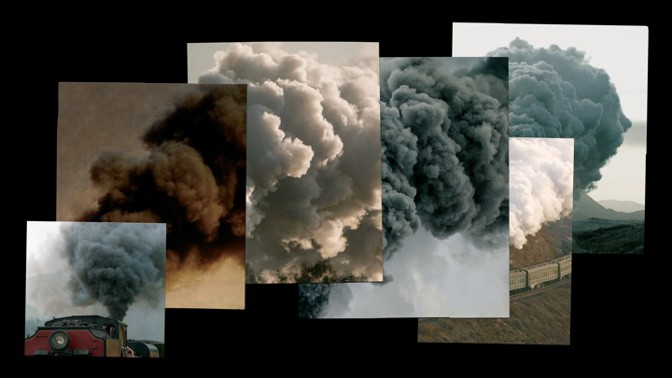It’s Tuesday, December 17. In today’s newsletter: Counting from the eve of an impeachment vote, 322 days until Election Day. Plus, David Graham on the fiction of two Trumps.
*
« TODAY IN POLITICS »

(FILIP BJORKMAN / SHUTTERSTOCK / ARSH RAZIUDDIN / THE ATLANTIC)
The Long Countdown
On the eve of impeachment and before the final Democratic debate of 2019, Washington punditry has been anxious to speculate on how much the 2020 election will be affected by the shadow of impeachment: either it’ll energize Democrats sick of Trump, or it’ll mobilize Republicans who see overreach on the left.
Impeachment feels all-consuming. But here’s a reminder that Election Day is a long time away—so much more could happen, and so much could be forgotten.
One day until the House impeachment vote. It’s a historic day, but there’s not a whole lot of suspense to it.
Two days until the next Democratic debate. This Democratic field started as the most-diverse ever, but Thursday’s debate will feature just one candidate of color: Andrew Yang, who just barely qualified.
48 days until the Iowa caucuses, which officially kick off the 2020 primary. Iowans take a lot of pride in getting to vote first—but that’s if they can vote at all. The caucuses have long faced criticism for being inaccessible.
77 days until “Super Tuesday.” The early states may get most of the attention at this point, but Super Tuesday, when 14 states hold their primaries, could be the field really starts to winnow. Do lagging candidates like Senator Cory Booker have the resources to stay in this long?
209 days until the start of the Democratic National Convention. What if the party still hasn’t coalesced around one candidate by then? Harry Reid, the former Senate majority leader, could play a key role in mediating the various factions.
322 days until Election Day 2020. On the GOP side, Donald Trump’s go-to strategy has been ginning up support from his base. But that may not be enough for him to win a second term.
—Saahil Desai
*
« SNAPSHOT »

(Jonathan Ernst / Reuters)
Mitch McConnell holds his weekly news conference at the U.S. Capitol on December 17.
*
« IDEAS AND ARGUMENTS »

(Erin Schaff / The New York Times)
1. “In other words: It’s more of the same. Much more.”
The president’s allies have tried to ask the public to distinguish between the president’s tweets and his official acts. But another new letter from the president—a six-pager to Nancy Pelosi—is yet more evidence to the contrary, David Graham writes.
For the most part, the letter is a farrago of common complaints the president has issued in rallies and on his Twitter feed. The president may be most comfortable at 280 characters, but he can expand to six pages given the opportunity. But even though the substance is recycled, the letter is notable because it’s an official communication, on White House letterhead.
2. “The Republicans may be trying to score points, and nothing more, by noting that Congress has not pursued other remedies.”
The Republican impeachment defense of Donald Trump centers on four easily disprovable points, but their larger point that Democrats should’ve “pursued other remedies” is legitimate: Democrats should fight for the courts to compel Mike Pompeo, Mick Mulvaney, Rick Perry, John Bolton and more to testify before Congress, Conor Friedersdorf argues.
3. “The bitter experience in Iraq and Afghanistan has undercut public faith in those entrusted with making and implementing American foreign policy.”
After the release of the Afghanistan Papers, what lessons should America’s military and foreign policy establishment take away? First, success can’t be assumed, especially in a major foreign intervention like Iraq, Tamara Coffman Wittes and Kevin Huggard argue. And when missions fail, leaders should look for an off-ramp—fast.
*
« EVENING READ »

(Stephen Voss / Redux)
Train Blame
New research analyzed by our climate reporter Robinson Meyer reveals how the four biggest American freight railroad companies have funded and advanced the climate-denial movement for decades, despite touting rail as the cleanest way (in one respect, it is) to move materials around the country.
Why did railroads invest millions in climate-science denial? Perhaps because coal makes up almost one of every three tons of American rail freight. Nearly 70 percent of American coal is shipped by rail, often along “dedicated” lines that can “operate around the clock,” the rail association says on its website. The largest class of railroads made a combined $10.7 billion, or 14 percent of their revenue, hauling coal last year. So while rail companies say they emitted only about 0.6 percent of U.S. greenhouse-gas pollution last year, their indirect carbon footprint may be gargantuan.
*
Today’s newsletter was written by Saahil Desai and Christian Paz, and edited by Shan Wang. You can reply directly to this newsletter with questions or comments, or send a note to politicsdaily@theatlantic.com.
Your support makes our journalism possible. Subscribe here.

No comments:
Post a Comment